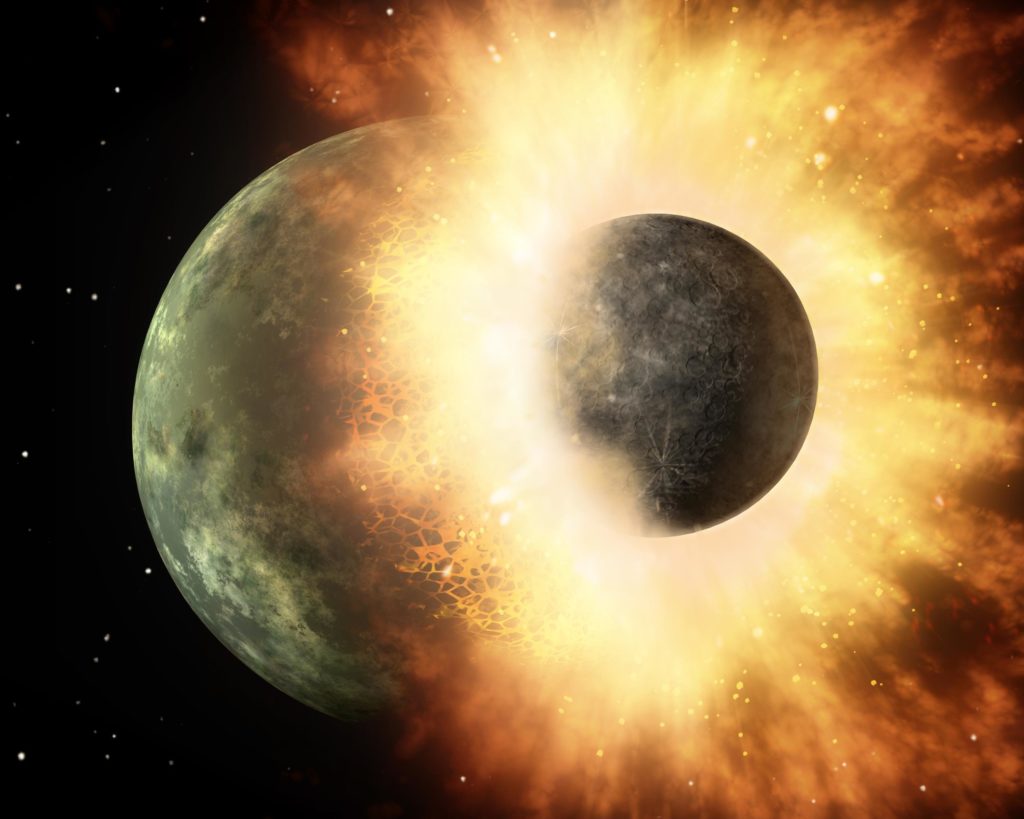Update on Our Miraculous Moon
How did the Moon form and why does it matter? Researchers have learned that the size of the colliding bodies that resulted in our Moon provides more evidence for lunar design.
I have written previously about the amazing fine-tuning in the formation of Earth’s Moon1 and the fine-tuned features it presently manifests that play crucial roles that make advanced life possible.2 The level of fine-tuning is so complex and exquisite that one Moon-formation expert wrote in Nature that it has caused “philosophical disquiet” among his colleagues.3 Now, new discoveries are sure to generate even more philosophical disquiet and hopefully greater acknowledgment of God’s role in designing the Moon for the benefit and destiny of humanity.
An Amazing Moon
Our Moon is like no other moon. Relative to the mass of its host planet it is 52 times larger than any other known moon. Thanks to the Moon’s extremely large mass relative to Earth’s, it confers these benefits:
- Earth’s rotation axis tilt varies by only ±1°.
- Earth’s rotation rate presently is 24 hours, slow enough to minimize pole-to-equator temperature differences and fast enough to maintain a stable rotation axis tilt.
- Earth receives extraordinary abundances of highly siderophile (iron-loving) elements (gold, platinum, palladium, iridium, rhenium, rhodium, ruthenium, and osmium) that are critical for sustaining high-technology civilization.
- Herbivores and carnivores on Earth have an optimal night light.
- Earth manifests an optimal ice age cycle for global civilization and a high human population.
Thanks to the Moon’s tiny iron core and porous crust, the Moon’s large mass is complemented by a low density. Hence, the Moon has a large diameter for its mass (it’s big but not heavy). Presently, the Moon subtends an angle in the sky from the perspective of Earth’s surface that is identical to the angle subtended by the Sun. This fortuitous and unique identity means that humans on Earth witness perfect solar eclipses. The opportunity for astronomers to observe perfect solar eclipses gives them a unique tool to study the solar corona as far away as 10° from the Sun’s visible disk. Perfect solar eclipses also permit detailed observations of the Sun’s atmosphere, chromosphere, and flares. Much of what astronomers have discerned about stellar coronae, chromospheres, atmospheres and flaring has come by observing multiple perfect solar eclipses. The timing of solar eclipses allowed historians to produce a calendar of events during humanity’s early history.
Perfect solar eclipses also provided the first confirmation of Albert Einstein’s theory of general relativity. Einstein’s theory asserted the universe had a finite age—it had a beginning, which implied that there was a cosmic Beginner, one that matches the Bible’s description of God.
If it were not for our Moon possessing precisely the features that it does, advanced life would not be possible. Furthermore, humans would not possess as much compelling scientific evidence as they do for God’s existence, character attributes, and the divine inspiration of the Bible.
New Discoveries Add Design Evidence
Over a decade ago, astronomers established that the Moon formed as a result of a planet that they named Theia, roughly the mass of Mars, colliding with the primordial Earth. However, a set of measurements indicated that both Earth and the Moon possessed the same oxygen isotope ratios.4 This identity either implied that the two planets had identical initial compositions or that during the collision their compositions got completely mixed together. For the latter scenario to occur, the masses of each body would need to be similar.
For the initial compositions of the pair to be nearly identical, Theia would need to form at the same orbital distance from the Sun as the primordial Earth. Though not impossible, such a scenario poses difficult challenges in attempts to model the dynamics of the early solar system. As for Theia and the primordial Earth possessing nearly similar initial masses, to date astronomers have been unable (with that assumption about masses) to produce a Moon-formation model that yields the present properties of the Moon and Earth.
In modeling the geochemical influences of the Moon-forming impact event on Earth’s mantle, three geophysicists showed that a Theia larger than 15 percent of Earth’s present mass always negated the present-day concentrations of the siderophile elements nickel, cobalt, chromium, and vanadium.5 However, a Theia that was only 11–15 percent of Earth’s present mass meant that the present Earth and Moon must, at least to some degree, possess distinct oxygen isotope compositions.
In a recent issue of Nature Geoscience, a team of three planetary astronomers presented high-precision oxygen isotope analyses of different lunar lithologies (rock units).6 Their analyses established that the Moon and Earth indeed have distinctly different oxygen isotope compositions. Specifically, the three planetary astronomers showed that while the crustal rocks of the Moon and Earth exhibit similar oxygen isotope ratios, rock samples derived from the deep lunar mantle are isotopically heavy compared to Earth. These findings imply that the deep interior of the Moon possesses the isotopic composition of Theia whereas the lunar surface and upper mantle has been completely homogenized by the Theia-primordial Earth impact event.
Philosophical Implications
The new discoveries have resolved the last remaining significant anomalies in models for the formation of the Moon. The new, reliable constraints on Theia’s mass are consistent with all the observed features of the present-day Moon and Earth. Quantitative evidence now permits Theia to form at an orbital distance different from Earth’s. These two discoveries mean that the previously demonstrated evidence for extraordinary, exquisitely fine-tuned designs in the Moon-forming collision event is now firmly established and, with it, evidence for a Moon-forming Fine-Tuner.
Image: Artist’s Conception of the Moon-Forming Event
Credit: NASA
Endnotes
- Hugh Ross, “The Remarkable Design of the Solar System’s Youth, Part 2,” Today’s New Reason to Believe (blog), June 6, 2011, /todays-new-reason-to-believe/read/tnrtb/2011/06/06/the-remarkable-design-of-the-solar-system-s-turbulent-youth-part-2; Hugh Ross, “Increasing Lunar Coincidences Lead to ‘Philosophical Disquiet,’” Today’s New Reason to Believe (blog), February 3, 2014, https://www.reasons.org/articles/increasing–lunar–coincidences–lead–to–philosophical–disquiet; Hugh Ross, Improbable Planet (Grand Rapids: Baker, 2016), 48–59, https://support.reasons.org/purchase/improbable-planet; Hugh Ross, “Where Did Earth Get Its Fine-Tuned Supply of Water?” Today’s New Reason to Believe (blog), August 6, 2018, /todays-new-reason-to-believe/read/todays-new-reason-to-believe/2018/08/06/where-did-earth-gets-its-fine-tuned-supply-of-water.
- Hugh Ross, “Solar and Lunar Tides Designed for Complex Life,” Today’s New Reason to Believe (blog), March 25, 2019, /todays-new-reason-to-believe/read/todays-new-reason-to-believe/2019/03/25/solar-and-lunar-tides-designed-for-complex-life; Hugh Ross, “Lunar Designs Optimize Life for Both Predators and Prey,” Today’s New Reason to Believe (blog), November 20, 2017, /todays-new-reason-to-believe/read/todays-new-reason-to-believe/2017/11/20/lunar-designs-optimize-life-for-both-predators-and-prey; Hugh Ross, “Thank God for Perfect Solar Eclipses,” Today’s New Reason to Believe (blog), July 10, 2017, /todays-new-reason-to-believe/read/todays-new-reason-to-believe/2017/07/10/thank-god-for-perfect-solar-eclipses; Hugh Ross, “Rare Moon Just Got Rarer,” Today’s New Reason to Believe (blog), June 5, 2017, /todays-new-reason-to-believe/read/todays-new-reason-to-believe/2017/06/05/rare-moon-just-got-rarer; Hugh Ross, “Yet More Reasons to Thank God for the Moon,” Today’s New Reason to Believe (blog), November 22, 2016, /todays-new-reason-to-believe/read/todays-new-reason-to-believe/2016/11/22/yet-more-reasons-to-thank-god-for-the-moon; Hugh Ross, “Confirming the Moon’s Vital Role,” Today’s New Reason to Believe (blog), November 10, 2008, /todays-new-reason-to-believe/read/tnrtb/2008/11/10/confirming-the-moon’s-vital-role.
- Tim Elliott, “A Chip Off the Old Block,” in “Shadows Cast on Moon’s Origin,” Nature 504 (December 5, 2013): 90, doi:10.1038/504090a.
- U. Wiechert et al., “Oxygen Isotopes and the Moon-Forming Giant Impact,” Science 294, no. 5541 (October 12, 2001)é: 345–48, doi:10.1126/science.1063037; Michael J. Spicuzza et al., “Oxygen Isotope Constraints on the Origin and Differentiation of the Moon,” Earth and Planetary Science Letters 253, nos. 1–2 (January 2007): 254–65, doi:10.1016/j.epsl.2006.10.030; Edward D. Young et al., “Oxygen Isotopic Evidence for Vigorous Mixing During the Moon-Forming Giant Impact,” Science 351, no. 6272 (January 29, 2016): 493–96, doi:10.1126/science.aad0525.
- Hélène Piet, James Badro, and Philippe Gillet, “Geochemical Constraints on the Size of the Moon-Forming Giant Impact,” Geophysical Research Letters 44, no. 23 (December 2017): 11,770–77, doi:10.1002/2017GL075225.
- Erick J. Cano, Zachary D. Sharp, and Charles K. Shearer, “Distinct Oxygen Isotope Compositions of the Earth and Moon,” Nature Geoscience 13 (March 9, 2020): 270–74, doi:10.1038/s41561-020-0550-0.







